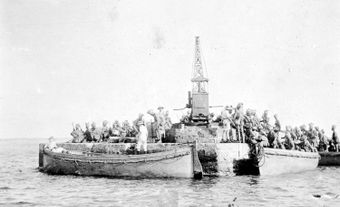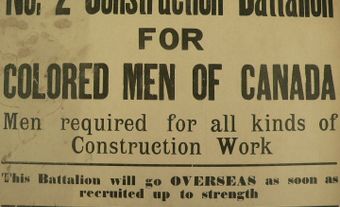The First World War occurred between 1914 and 1918. Approximately 425,000 Canadians served overseas in Europe. More than 60,000 Canadians died. Over 170,000 were seriously wounded. Canadians suffered more casualties in the First World War than the Second World War. (See Second World War (Plain-Language Summary).)
(This article is a plain-language summary of the First World War. If you are interested in reading about this topic in more depth, please see our full-length entry, First World War.)

Canada and the Start of the War
When Britain declared war on Germany on 4 August 1914, Canada was at war too. Canada’s foreign affairs were still directed by Britain. So, Canada had to go to war. Canadians were enthusiastic about the war in 1914. They thought it would end quickly. By early October more than 30,000 volunteered to join the Canadian Expeditionary Force (CEF). Hundreds of thousands would volunteer during the war.
Canada in the War
Canadians fought in many battles during the war. Some of the most famous battles were at Ypres, the Somme, Vimy Ridge, and Passchendaele. The battles at Vimy Ridge and Passchendaele were great victories for Canada. Thousands of Canadians were killed and wounded during these battles. Some historians have argued that Vimy was the most important battle for Canada. At the battle of Vimy Ridge, four Canadian divisions attacked the Germans. This was the first time that all the Canadian divisions fought together. Before this, they fought alongside the British. According to many historians, this battle contributed to making Canadians proud of their country.
The Conscription Crisis
Compulsory military service is called “conscription.” Prime Minister Robert Borden decided to introduce conscription in 1917. He believed that Canada needed more soldiers. And he wanted Canada to be more independent of Britain. To do this, Canada needed a large army. Many people were against conscription. Farmers were against conscription because they wanted their sons to stay at home to work. Union leaders and socialists thought the war was unjust. J.S. Woodsworth was the most famous of these socialists.
French Canadians were the most opposed to conscription. A large percentage of French Canadians were against the war. They did not feel attached to Britain. And they were suspicious of English Canadians already. They worried that they would lose their language and their culture. French opposition to conscription was led by Henri Bourassa and Wilfrid Laurier. They lost. Borden beat Laurier in the election of 1917. Conscription began in 1918. In April 1918 opponents to conscription rioted in Quebec City. The is called the conscription crisis of 1918. It made many in “French Canada” distrust “English Canada” more than ever before.
Legacies of the First World War
The First World War further industrialized Canada. Munition factories were built in many cities. This, in turn, contributed to urbanization. Women has more opportunities because of the war. Many women worked in munitions factories. Women who had a husband, brother or son in the military could vote in federal elections. Women serving in the military could also vote. The war gave the state a large role in the Canadian economy. The state planned what would be produced and the prices of products. Before the war, the state played a small role in the economy.
The war made many Canadians prouder of being a Canadian than ever before. Thanks to the war, Canada became more independent from Britain than ever before as well. The war also set a precedent when it came to the loss of rights and freedoms. Canadians lost these rights and freedoms when the government invoked the War Measures Act. It would do so again during the Second World War. Lastly, the war left a tragic legacy for families across Canada. Tens of thousands of soldiers never returned home.

 Share on Facebook
Share on Facebook Share on X
Share on X Share by Email
Share by Email Share on Google Classroom
Share on Google Classroom



